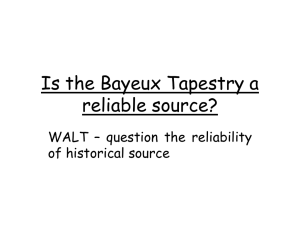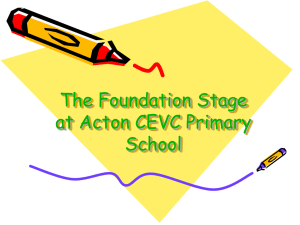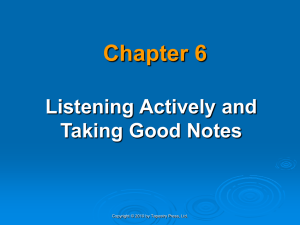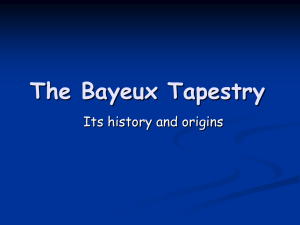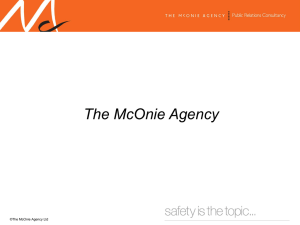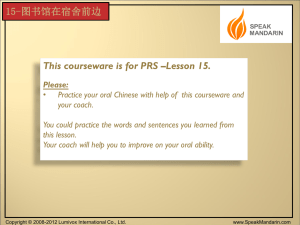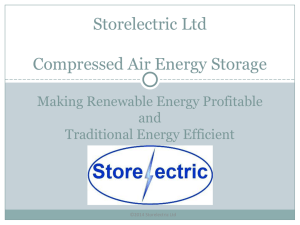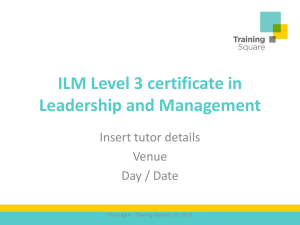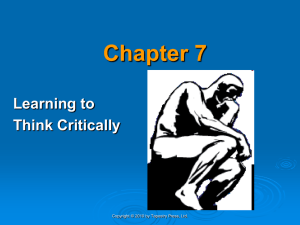Chap 12 Planning for Your Career
advertisement
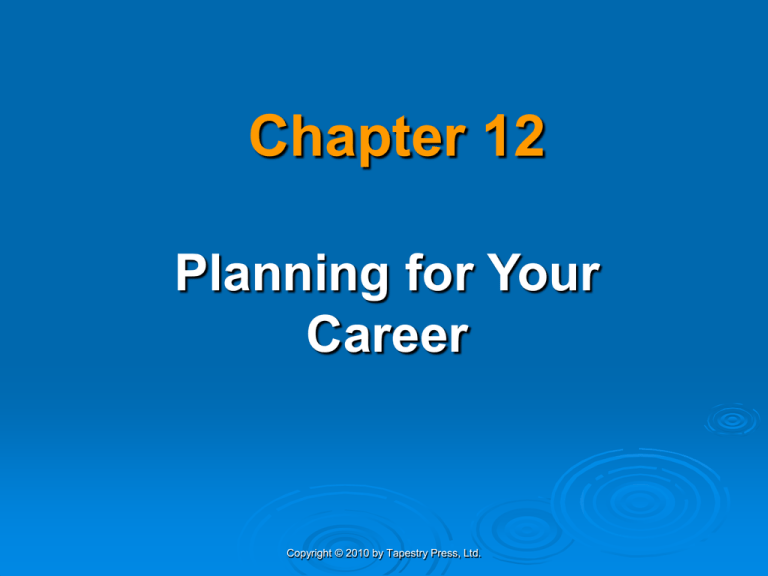
Chapter 12 Planning for Your Career Copyright © 2010 by Tapestry Press, Ltd. Purpose of This Chapter This chapter will help you engage in: 1. 2. 3. Self-assessment related to work attributes Career exploration Planning skills . . . that will culminate in a successful career plan. Copyright © 2010 by Tapestry Press, Ltd. A R E Y O U R E A D Y ? Copyright © 2010 by Tapestry Press, Ltd. Learning Outcomes 1. 2. 3. 4. 5. 6. Assess your work-related: values, interests, personality type, and skills. Investigate career options based on your self-assessment. Conduct a job informational interview. Conduct job searches. Network. Market yourself for a job via a résumé, cover letter, application, portfolio, and job interview. Copyright © 2010 by Tapestry Press, Ltd. CAREER DECISION-MAKING: A Life-Long Process 1. What you learn in this chapter will be repeated at various times throughout your life. 2. You will continually upgrade your career decision-making skills to carry out realistic and fulfilling career and life plans. Reflect on this—what does this mean to you? Copyright © 2010 by Tapestry Press, Ltd. Career planning is . . . . . . always subject to new learning about yourself and about emerging careers. Copyright © 2010 by Tapestry Press, Ltd. Self-Assessment for Career Exploration 1. 2. 3. 4. Values—what matters most to you Interests—what you enjoy doing Personality Type—your character, traits, and nature Skills—what you are good at Knowing yourself can help you find a satisfying career. Copyright © 2010 by Tapestry Press, Ltd. Assess Your Values Work Values What you consider to be important, worthy, or meaningful for your job satisfaction. A few examples: helping others, managing projects or people, becoming wealthy, using or developing new technology, job or family security, working with your hands or with nature, having a sedentary or a physical activity job, working independently or with a team, and many more. Copyright © 2010 by Tapestry Press, Ltd. Exercise 12-1: My Work Values 1. 2. 3. Not everyone believes work and values must be aligned. But values often influence the kind of work you choose. Use your assessed work values from Exercise 12-1: My Work Values, to help you consider what types of jobs match your values. Copyright © 2010 by Tapestry Press, Ltd. JOB VALUES What do you consider to be important, worthy, or meaningful? From Exercise 12-1: My Work Values Discuss with your classmate After determining your top five work values and the types of jobs that are likely to satisfy those values, what conclusions can you derive from Exercise 12-1? Copyright © 2010 by Tapestry Press, Ltd. Assess Your Interests 1. Interests are reflected in the activities you enjoy doing and in your affinities. 2. Identifying your interests and finding employment that matches your interests obviously provides greater work satisfaction. Copyright © 2010 by Tapestry Press, Ltd. Interest Interview Use the following questions to interview a classmate. What are your favorite hobbies? What are your favorite recreation activities? What political causes are important to you? What are your scientific, artistic, and/or other subject area interests? 5. What other activities do you enjoy? 1. 2. 3. 4. 6. 7. See any “interest” theme from your responses? Any conclusions about jobs that may match your interests? Copyright © 2010 by Tapestry Press, Ltd. Personality Types and Aligned Work Environments Copyright © 2010 by Tapestry Press, Ltd. John Holland’s Theory of Career Choice 1. 2. 3. Holland’s theory states that “the choice of a vocation is an expression of personality.” Career choices consistent with your personality are likely to lead to job success and satisfaction. Holland developed a six factor typology to describe both persons and work environments. Copyright © 2010 by Tapestry Press, Ltd. John Holland’s Theory of Career Choice continued 4. This theory is the best known and most widely researched theory on this topic and is used by most career counselors and the U.S. Department of Labor. 5. The next slides display and explain the six personality types and work environments. Copyright © 2010 by Tapestry Press, Ltd. The six personality and work environment types described by Holland are as follows: 1. 2. 3. 4. 5. 6. Realistic—practical, physical, hands-on, tooloriented (Doer) Investigative—analytical, intellectual, scientific, explorative (Thinker) Artistic—creative, original, independent, chaotic (Creator) Social—cooperative, supporting, helping, healing/nurturing (Helper) Enterprising—competitive environments, leadership, persuading (Persuader) Conventional—detail-oriented, organizing, clerical (Organizer) Wikipedia http://en.wikipedia.org/wiki/Holland_Codes Copyright © 2010 by Tapestry Press, Ltd. John Holland's Theory of Career Choice continued 6. You are a combination of all six personality types. 7. However, you are likely to be dominant in three personality types. 8. Holland classifies occupations using the three highest or dominant personality types. Copyright © 2010 by Tapestry Press, Ltd. Your “Holland Personality” Results Discuss with your classmate: 1. Based on the textbook’s John Holland Occupational Personality Assessment, what were your top three personality types? 2. and corresponding scores? Copyright © 2010 by Tapestry Press, Ltd. John Holland’s Hexagon model shows relationships between the personality types/ work environments. Note personality types closest to each other are more alike than those farther away. Copyright © 2010 by Tapestry Press, Ltd. Relationship between the personality types and work environments. Personality Types ______________ 1. 2. 3. 4. 5. 6. Realistic Investigative Artistic Social Enterprising Conventional Compatible Work Environments ________________________________ 1. Realistic, Investigative, Conventional 2. Investigative, Realistic, Artistic 3. Artistic, investigative, Social 4. Social, Artistic, Enterprising 5. Enterprising, Social, Conventional 6. Conventional, Enterprising, Realistic Copyright © 2010 by Tapestry Press, Ltd. Continue to discuss with your classmate. . . Review the occupations listed in your text that are listed in each of your top three personality types. 1. What occupations listed in your top three personality types are of strong interest to you? 2. What new job titles have recently been developed (but not listed in the text) and are likely to be listed in these personality types? Note: New and emerging jobs are continually added as new fields and technologies emerge. Copyright © 2010 by Tapestry Press, Ltd. Assess Your Skills 1. 2. 3. The skills you have strongly influence your career options. Skills are abilities you can immediately apply in specific tasks or functions. Marketable skills are key selling points on your résumé—they’re the skills your employer hired you for. Copyright © 2010 by Tapestry Press, Ltd. Three Types of Skills 1. Transferrable skills are competencies you learn in one environment that can easily be employed in other settings. 2. Work-specific skills are abilities you have learned specifically for the job. 3. Self-management skills relate to how you manage yourself, how well you perform, and your temperament. Give examples of each of the three skills above which you possess. Copyright © 2010 by Tapestry Press, Ltd. Go to the O*NET Connector http://www.onetcodeconnector.org/ . . . to learn what skills are required for a job in which you have an interest. Note: At this website, the work-specific skills are called, “Detailed Work Activities.” Copyright © 2010 by Tapestry Press, Ltd. Job Search Strategies Class Brainstorm: Let’s list all the ways we can think of to search for a job. Copyright © 2010 by Tapestry Press, Ltd. Informational Interviews 1. Talking to people about their jobs/careers, without an expectation of a job offer, is a fantastic way to investigate career options. 2. It is less stressful than a job interview and you are asking the questions because you want to learn about the job. 3. You can learn about the pros and cons of a job as well as the workplace. Copyright © 2010 by Tapestry Press, Ltd. Informational Interviews continued 4. It’s always good to talk to several individuals to get different takes on the job/career. 5. Send a thank you note. 6. You could ignite the interest of a perspective employer—it happens occasionally! Copyright © 2010 by Tapestry Press, Ltd. Informational Interviews Questions Discuss in small groups and record: What questions you would like to ask to learn about the job and workplace. Share your questions with the class. Copyright © 2010 by Tapestry Press, Ltd. College Placement Services What kind of career and placement services does our College provide? Copyright © 2010 by Tapestry Press, Ltd. Networking to help you identify job openings and make job contacts. Some of the best jobs aren’t listed anywhere except in the mental catalogues of CEOs, managers, and others in the know! Copyright © 2010 by Tapestry Press, Ltd. Group Brainstorm/Group Share List possible networking contacts. List possible places to network. How can you prepare for networking? 1. 2. 3. 4. How would you approach individuals? What kinds of information will you seek? . . . and provide? How would you recommend following up your networking? Copyright © 2010 by Tapestry Press, Ltd. Investigating Career Options Copyright © 2010 by Tapestry Press, Ltd. O*NET Resource Center http://www.onetcodeconnector.org/ 1. 2. 3. 4. 5. Is the nation’s primary source of occupational information. Contains information on hundreds of standardized and occupation-specific descriptors. Is continually updated by surveying a broad range of workers from each occupation. Is an interactive application for exploring and searching occupations. Has career exploration tools and assessment instruments for workers and students looking to find or change careers. Copyright © 2010 by Tapestry Press, Ltd. Occupational Outlook Handbook (OOH) (U.S. Dept of Labor) http://www.bls.gov/oco/ Use to investigate occupational information on: 1. 2. 3. 4. 5. 6. Training and education needed Earnings Expected job prospects What workers do on the job Working conditions In addition, the Handbook gives you job search tips, links to information about the job market in each state, and more. Note: the OOH is revised every two years. Copyright © 2010 by Tapestry Press, Ltd. CareerOneStop (CareerInfoNet) http://www.careeronestop.org/ Another comprehensive career resource library containing: 1. Career exploration resources 2. Salary and benefit information 3. Education and training information 4. Job search sites for each state 5. Occupational profiles by state 6. Résumé and interview help 7. Other related services and more Copyright © 2010 by Tapestry Press, Ltd. Marketing Yourself for the Job Résumé Cover Letter Application Portfolio Job Interview Copyright © 2010 by Tapestry Press, Ltd. The Résumé 1. Is the first step in marketing you for the job—concisely listing your contact information, credentials, achievements, work and educational background. 2. Purpose—to get the prospective employer interested in interviewing you. 3. Employers want a résumé to show a clear match between the applicant and the job. 4. Note—there are many and varied approaches to constructing a résumé. 5. Give yourself plenty of time to construct your résumé and get a competent proofreader to check it. Copyright © 2010 by Tapestry Press, Ltd. The Résumé How to Instantly Catch the Reader’s Eye 1. Identify the area(s) in which you can make a contribution. 2. Can take one of several—or a combination—of forms: a. Professional Objective statement: Should state the position you are applying for. Can include a strong and concise statement that shows the employer how you meet their needs. May also follow with a list of qualifications you bring to the position. Can also show that you can bring added value. Should persuade the employer to read the rest of your résumé. Copyright © 2010 by Tapestry Press, Ltd. To Include or Not to Include a Professional Objective Statement? • Some people choose to omit the objective statement because they believe it is limiting. Some employers want to see an objective to size up your intentions. Other employers say objectives are often poorly written and waste space. • • Discuss reasons you may or may not want to include an objective on your résumé. Copyright © 2010 by Tapestry Press, Ltd. Other Résumé Openers 1. Headline statement—simply the title of the position you’re applying for (and adjusted for every job you apply for). 2. Branding statement—ad-like statement that tells immediately what you can bring to the employer. Copyright © 2010 by Tapestry Press, Ltd. Headline and Branding Statement Used in Combination Example: PROJECT MANAGER Specialize in upgrading business information systems, designing strategy, managing risk, implementing training, and improving the quality and caliber of operations. Copyright © 2010 by Tapestry Press, Ltd. Another Approach (from Monster.com) Dedicated health information technician (HIT) with seven years of acute-care hospital medical records coding experience. Additional four years of experience as a medical office administrative manager in a rehabilitation setting. Completed full-time HIT program in 2002. Qualifications include: Registered Health Information Technician (RHIT) certification AAS degree in Health Information Technology Expertise in ICD-9-CM and CPT coding Knowledge of licensing, reimbursement and accreditation standards Copyright © 2010 by Tapestry Press, Ltd. Include Accomplishments on Your Résumé 1. 2. 3. 4. 5. 6. 7. Focus on accomplishments that set you apart from other job candidates. In each job, what special things did you do to set yourself apart? How did you do the job better than anyone else or than anyone else could have done? What were the problems or challenges that you or the organization faced? What did you do to overcome the problems? What were the results of your efforts? How did the organization benefit from your performance? How did you leave your employers better off than before you worked for them? Copyright © 2010 by Tapestry Press, Ltd. Résumé Group Discussion There are many possible ways to construct a résumé, so let’s first discuss category headings. 1. 2. 3. Think of all the possible category headings you could put on a resume. What will you name these categories? How will you order your categories? Copyright © 2010 by Tapestry Press, Ltd. Résumé Tips 1. When you see descriptions of jobs you want, pay close attention to the skills the employer wants, and make sure you address them in your résumé. 2. Always portray your skills in your résumé as applicable to the job you seek. Copyright © 2010 by Tapestry Press, Ltd. Which will you choose? Why? 1. Functional Résumé—highlights an applicant’s specific experience and skills rather than a chronological listing of work history experience. 2. Chronological Résumé—highlights an applicant’s work history starting from the most recent work experience listed in reverse chronological order. 3. 4. Combination of both—describe this combo. Which type would you choose? Copyright © 2010 by Tapestry Press, Ltd. References Who should you select for references? Copyright © 2010 by Tapestry Press, Ltd. Reference Tips 1. “References furnished upon request” is not essential on the bottom of your résumé. It may be eliminated, especially if space is needed for pertinent information. 2. Have references available on another typed sheet of paper for the interview. 3. List at least three people (not relatives) who have recognized your skills, accomplishments, or performance. Copyright © 2010 by Tapestry Press, Ltd. Cover Letters 1. It is important to remember that cover letters are sales letters, and you are the product. 2. Cover letters serve to introduce you to an employer, and résumés tell about you. 3. Like the résumé, the cover letter is an important marketing tool. Copyright © 2010 by Tapestry Press, Ltd. Cover Letter Format Tips 1. Make every effort to address your cover letter to a specific person—avoid the “Dear Sir or Madam.” Search the “about us” pages on the company web site for names of individuals to address. Use “Dear Employer” as a last resort. 2. Use your first paragraph to: State the name of the position and include the name of a mutual contact, if you have one. State where you heard about the job. Create interest and focus on what you have to offer relative to the employer’s needs. Refer to your attached/enclosed résumé. Copyright © 2010 by Tapestry Press, Ltd. Cover Letter continued 3. Use the next paragraph(s) of the letter to address why you are the best candidate for the company and specific position. You can also communicate that you match or exceed the qualifications/requirements listed in the job description. Note: Try not to repeat your résumé—just introduce the highlights that encourage them to read your résumé thoroughly. Copyright © 2010 by Tapestry Press, Ltd. Cover Letter continued 4. Conclude your cover letter by thanking the employer for considering you for the position. Include information on how you will follow up. I will contact you the week of ____________. to inquire about an interview. OR . . . what other clever statement/reasons could you pose for a follow-up call? Copyright © 2010 by Tapestry Press, Ltd. Cover Letter continued Like a résumé . . . There are many and varied approaches to constructing a cover letter. Give yourself plenty of time to construct your cover letter and get a competent proofreader to check it. Copyright © 2010 by Tapestry Press, Ltd. Do you need a Job Portfolio? No—a job portfolio is not necessary, but it can: 1. Make a good impression on an employer or an interview team. 2. Set you apart from other job candidates— giving you a competitive edge. 3. Showcase your skills, accomplishments, and your quality. Copyright © 2010 by Tapestry Press, Ltd. Portfolio Tips 1. Use a three-ring binder so you can add and subtract documents. 2. The first page of the portfolio should be your index/overview of what is contained in the portfolio. 3. Documents to include next slide Copyright © 2010 by Tapestry Press, Ltd. Portfolio Documents 1. 2. 3. 4. 5. 6. 7. 8. 9. 10. 11. Résumé or vitae Most recent licenses, certificates, professional registrations, or other credentials Degrees and training completion certifications Achievements and recognitions/awards Evidence of creative projects Writing samples and/or publications Letters of recognition Evidence of presentations at conferences, etc. Photos that showcase accomplishments Memberships and offices held in professional organizations What else? Copyright © 2010 by Tapestry Press, Ltd. Completing a Job Application— Another Piece of Self-Marketing Tell me some Do’s and Don’ts for completing a job application. Copyright © 2010 by Tapestry Press, Ltd. The Job Interview 1. 2. Interviewing also varies widely, based on industry, occupation, employer, and position. Generally, the higher paid the job, the longer and more rigorous the selection process. Copyright © 2010 by Tapestry Press, Ltd. Interview Variances Some Interviews include: Interview committees—then meet the CEO. On rare occasions, all candidates are interviewed in the same room, same time. May require a writing sample, presentation, or test during the interview process. Any other experiences? Copyright © 2010 by Tapestry Press, Ltd. Interview Preparation Learn everything you can about the employer, the position, and business/industry—including the major competitors in the field. 1. Go to the employer’s Web site and study every page. You will likely pick up some information and language that you can use in the interview. Copyright © 2010 by Tapestry Press, Ltd. Interview Preparation continued 2. When you set up the interview schedule, ask who you will be talking to and how best to prepare. 3. Practice responding to potential questions— even the tough questions like: “Where do you see yourself in five years?” OR “Why are you unemployed?” 4. Prepare questions to ask during interviews— for example: “Is there any qualification for this position that you think I am missing?” This gives you clues about concerns you could address further. Copyright © 2010 by Tapestry Press, Ltd. And don’t forget to bathe nicely for the interview! Copyright © 2010 by Tapestry Press, Ltd. Class Share 1. Let’s hear about some of your experiences with interviews. 2. Based on your experiences, is there any advice you have about interview preparation? Copyright © 2010 by Tapestry Press, Ltd. Don’t Forget Send a thank you e-mail after your interview. What should you say? Copyright © 2010 by Tapestry Press, Ltd. Discussion: Career Changes 1. 2. 3. Does anyone remember the days when workers and employers remained loyal to one another for 30 or more years? Why are job and career changes more frequent today? How can you thoughtfully plan for job and career change that will lead you to the next position? Copyright © 2010 by Tapestry Press, Ltd. Career Changes More often than not, the need for job or career change happens unexpectedly, when one is least prepared, and so it carries with it fear, frustration, and immobilization. Reflect on this. Copyright © 2010 by Tapestry Press, Ltd. Key Chapter Points 1. 2. 3. 4. Knowing your work-related values, interests, personality type, and skills can help you find a satisfying career. According to John Holland, “the choice of a vocation is an expression of personality.” Talking to people about their jobs/careers, without an expectation of a job offer, is a fantastic way to investigate career options. Some of the best jobs aren’t listed anywhere except in the mental catalogues of CEOs and managers—and networking helps you uncover jobs openings and good contacts. Copyright © 2010 by Tapestry Press, Ltd. Key Chapter Points 5. 6. 7. 8. continued There are many and varied approaches to constructing a résumé and cover letter. Give yourself plenty of time to construct your résumé and cover letter and get a competent proofreader to check it. Prepare for your interview by researching the job and company as well as practicing responses to questions. Do your homework assess your work values, interests, personality type, and skills; and then investigate jobs that match you. Copyright © 2010 by Tapestry Press, Ltd. This is my attentive interview face. Copyright © 2010 by Tapestry Press, Ltd.
